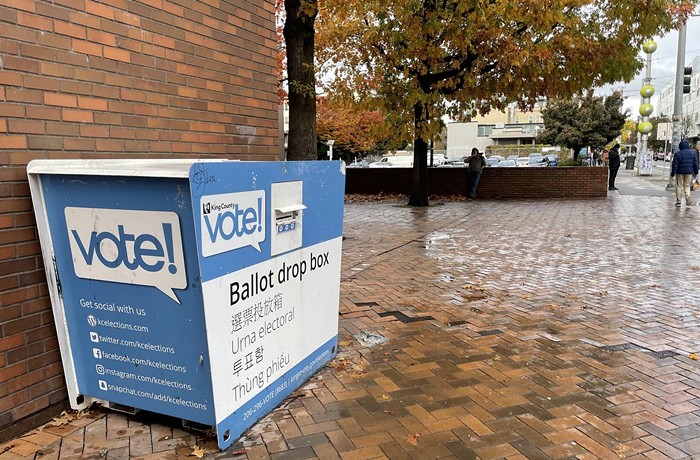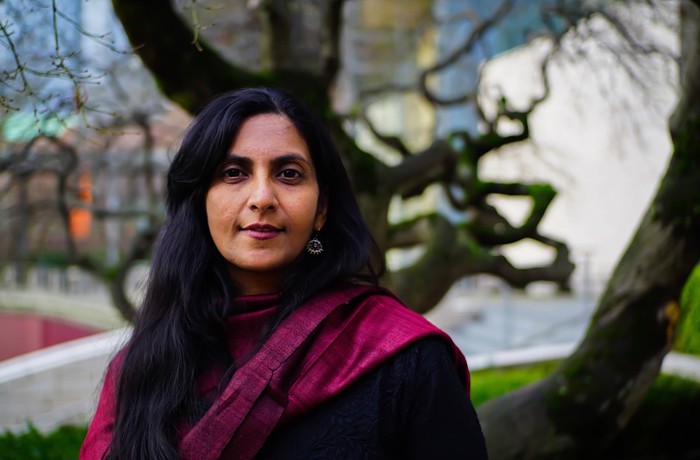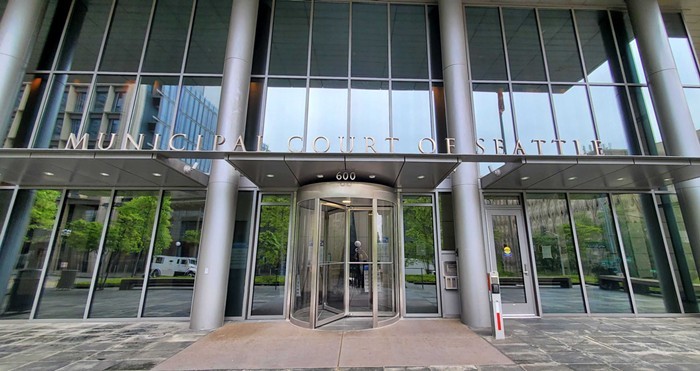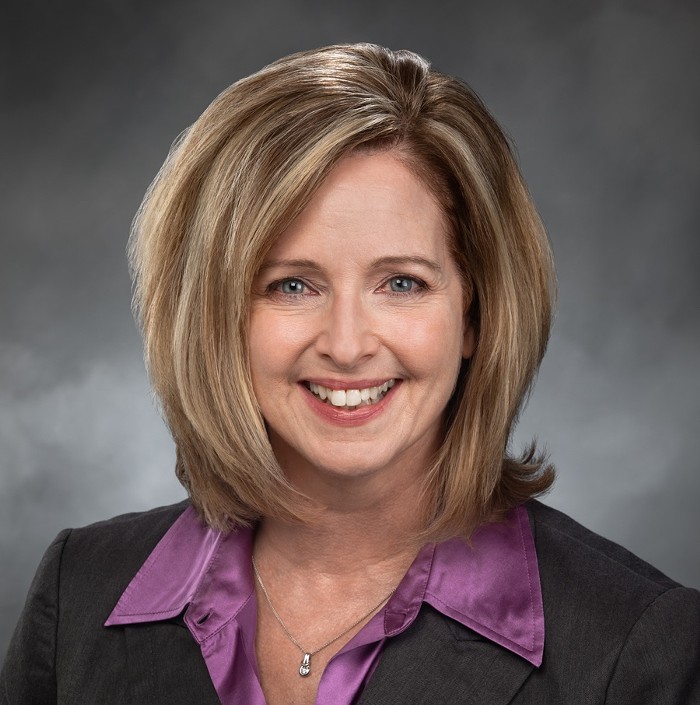Because district representation would diminish the chamber's power.
The citizens who drafted the initiative think the plan will solve a basic problem with Seattle's city council. None of Seattle's current nine council members have a well-defined constituency. All nine, by virtue of running citywide, speak for the same ill-defined "big picture." This abstract mandate translates into phantom representation. (Quick--who do you currently call in city hall if you want to fix that pothole?) Charter Amendment No. 5 would cure phantom representation by giving each council member a specific neighborhood constituency, which would hold council members accountable, giving each neighborhood a representative in city hall.
And contrary to conventional wisdom--that district representation would fragment the council and make it vulnerable to an empowered mayor--council members with well-defined constituents would actually be emboldened to take on the mayor's big-biz agenda (something the current at-large bunch seems unable to do). Clear-cut constituencies, you see, wouldn't only hold each council member accountable; they'd give each council member a power base. At-large council members have no base to tap when they want to challenge Team Nickels--after all, the mayor could care less about pissing off one random council member. But the mayor would think twice about messing with a council member if he or she had "Northgate" in his or her title. Nickels wouldn't want to lose the support of a specific neighborhood.
Under districts, it wouldn't take the council member who represents Northgate and the council member who represents South Lake Union much brains to recognize that they've got some common interests--namely, that their neighborhood plans are being trounced.
Neighborhood council members would be able to align around all sorts of issues: Cops aren't paying much attention (Crown Hill, Capitol Hill, Beacon Hill, South Park); residents don't have sidewalks (Greenwood, Rainier Beach, Lake City); a range of city agencies--like Seattle Parks and Recreation, or the Department of Design, Construction and Land Use (DCLU)--aren't responsive on density regulations, field lights, and cell phone towers (Magnuson Park, Columbia City, Ballard, West Seattle); the city's making public-property giveaways to local power players (Squire Park, Washington Park, South Lake Union). These neighborhood issues create bonds between neighborhood representatives--not fragmentation.
* * *
This isn't just political theorizing. All over the country, council members from Seattle-sized cities with district representation (45 of the country's largest 50 cities are districted) say that crosstown alliances are standard operating procedure.
"The fact of the matter is that you have to form alliances," says Albuquerque City Councilor Miguel Gómez (District 1). "You realize that you have to compromise a little bit. You vote for something you feel strongly about, and then you support issues that other councilors feel strongly about. I'm a progressive Democrat from a district that's 70 percent Hispanic, and I'm allied with a conservative from the wealthy, mostly Anglo Eastside."
Minneapolis City Council Member Robert Lilligren (Ward 8) says, "I represent a poorer neighborhood compared with what we call the 'fertile crescent'--the wealthier suburbs on the outskirts of the city--and I actually find myself allying with the 'fertile crescent' alderman on fiscal issues."
This could happen in Seattle, too. Exhibit A is Seattle's own Cross-Town Coalition, a group of leaders from Seattle's far-flung neighborhoods that banded together earlier this year and challenged the city's current priorities. The coalition held a packed, headline-grabbing summit on May 31 at the South Lake Union Armory ["Neighborhood Drive," Amy Jenniges, June 5]. The summit stopped the council in its tracks--just ask Council Member Richard Conlin, who's supposed to be the council's neighborhood guy--and forced the city to reevaluate Vulcan's corporate-park plan in South Lake Union. It's something the council should have done on its own, but with only one council member--rather than all nine--tending to the neighborhoods department, priorities got lost. The Cross-Town Coalition came together to fill the void left by today's weak at-large council.
Christine Lea, the South Lake Union rep on the Cross-Town Coalition, says, "The genesis of the group was that we were all realizing the same thing at the same time. Our neighborhood plans were being laid to waste. Ignored. Trounced. There was no focal point, no mechanism at city hall, to focus our discontent. So we created our own."
And the diverse neighborhoods were able to unite. "The common ground was the weak council," Lea says, "and how the council and the mayor were simultaneously pandering to special interests without proper public vetting. We recognized that we didn't just have a few things in common, but just about everything." Sure, each neighborhood has its specific concerns, but chances are those specific concerns have a common denominator. The gang problem in Crown Hill is at Northwest 85th Street and 14th Avenue Northwest, and the gang problem in West Seattle is at 16th Avenue Southwest and Southwest Roxbury Street, but they're both gang problems.
Lea cites widespread frustration with the city agencies, like the SPD and Seattle Parks and Recreation, that handle such things. "It can be as simple as the parks department--a uniform gripe citywide. Almost everyone finds that Parks is beholden to no one. It's the same for the cops and the DCLU. There's the same lack of concern for local accountability in every department, and it has to stop."
Lea's coalition is a model for what Seattle's city council could be. Seattle doesn't have to be stuck with the current model: a group of nine members who must each appeal to the exact same bloc of voters as the mayor--a recipe for homogeneous (rather than diverse) government. With districts, à la the Cross-Town Coalition, Seattle could tap the power of melting-pot democracy--making policy by finding the common denominator of neighborhood-by-neighborhood problems.
North Seattle coalition member Jan Brucker, a former community council president and co-chair for the Aurora/Licton Springs neighborhood planning group, says, "Neighborhoods have more in common with each other than they do with the notion that mayor knows all and knows best."
University District activist John Fox concludes, "The council's quickly falling over for the mayor's proposals. That's what prompted this coalition and galvanized it. It's an attempt to assert our power base." That "power base" scared the shit out of the business folks at the chamber who want to keep power and city spending focused downtown.
* * *
How do we know the chamber thinks empowering neighborhoods is a dangerous idea? Simple: The chamber--along with downtown players like Wright Runstad & Company and Pine Street Group LLC--is funding and staffing the anti-districts campaign. George Griffin, chair of the Alki Foundation (the lobbying wing of the Greater Seattle Chamber of Commerce), loaned a whopping $15,000 to the anti-districts campaign.
Griffin's group is called One Seattle--shorthand for the chamber's anti-districting spin. Chamber guy Griffin says he's afraid the council will become fragmented and lose sight of the "big picture."
Really, the chamber's not worried that the council will lose sight of the big picture. It's worried that a district formula will change the way the council paints the picture, placing less emphasis on the chamber's downtown constituency. After all, the legacy of the at-large council has been to pour hundreds of millions of dollars into downtown: $73 million to build a downtown parking garage for the Nordstrom family, $170 million for the expansion of the downtown Washington State Convention & Trade Center, $75 million to build a new downtown municipal building, and now a half-billion for South Lake Union. It's not bad to dedicate money to downtown projects, but this record is unbalanced.
This is because under the current scheme, the "big picture" is determined by the people with the money, time, money, access, money, lobbyists, money, influence, and money to frame the city's agenda around future promises--like those 20,000 jobs in South Lake Union.
This scheme is nothing more than Seattle's own version of trickle-down economics, a version that prioritizes--at the expense of funding for things like community service officers--citywide investment in Paul Allen's downtown corporate park (complete with a $45 million trolley). Vulcan, Paul Allen's real-estate company, is one of this year's top-10 council campaign donors--with the company and its associates kicking in a whopping $18,375 to city council incumbent Margaret Pageler alone. And Vulcan isn't exactly stingy with the other candidates: Jim Compton has gotten $13,000, Judy Nicastro has gotten $2,675, Peter Steinbrueck has gotten $1000, and Heidi Wills has gotten $11,265. (It's not surprising that Vulcan is also the top contributor to the anti-districts campaign, donating $5000.)
Citywide campaigns, which are more expensive to run than neighborhood campaigns, make candidates too dependent on big donors. (City council candidates need to raise $150,000 just to stay competitive with this year's average war chest.) In other words, citywide elections increase the power of someone like Paul Allen, who can round up nearly $50,000 to spread around. Obviously, we're not dumb enough to think districting will take money out of local politics. Allen could still dump money to every candidate in a districted system. But given that the amount of people a council candidate needs to reach would drop in a neighborhood campaign from something like an average of 145,000 to about 44,000, the threshold it takes to play would be lowered significantly--making it easier for less funded candidates to connect with constituents. It would also balance the playing field a bit so that downtown's clout isn't out of whack. It'd still have clout (and it should), just not a disproportionate amount. In summary: District campaigns increase the power of someone who can go out and knock on doors. Just ask Northeast Seattleite Bob Ferguson, who ran a shoe-leather campaign for the districted King County Council this fall, displacing a 20-year incumbent in the primary. Heck, a district candidate could even afford to turn down an Allen check.
Having the "big picture" bought and paid for weakens the council's ability to be a legislative force. When the "big picture" doesn't have to emerge organically from all the pieces of the puzzle (after all, each at-large council member pretends to know what the big picture is in advance), the Vulcan gets off easy. They don't have to run their agenda through the gauntlet of nine different constituencies, and so aren't forced to serve all the parts of the whole. They simply have to talk in abstractions about the trickle-down effects that will, one day, fuel the general fund--like Vulcan's ephemeral promise about creating 20,000 jobs in South Lake Union by 2020. (The Stranger's neighborhood reporter, Amy Jenniges, debunked this figure, by the way, in her May 22 story "a href=http://www.thestranger.com/2003-05-22/city.html>Playing the Numbers.")
* * *
Ultimately, the chamber of commerce can't just come out and say it doesn't like districts on the grounds that localized representation diminishes the power of its membership--i.e., of moneyed interests. So, it's got its catchy euphemism about losing sight of the "big picture."
But if the chamber thinks electing council members by districts will lead to a balkanized, squabbling council of provincial boobs, they haven't been paying attention to the success of the Cross-Town Coalition. Or perhaps the chamber has noticed the neighborhood power base--which may explain those $5000 contributions to the anti-districts campaign from the likes of Boeing, Safeco, and Vulcan.
Mahrya Draheim contributed to this screed.


















